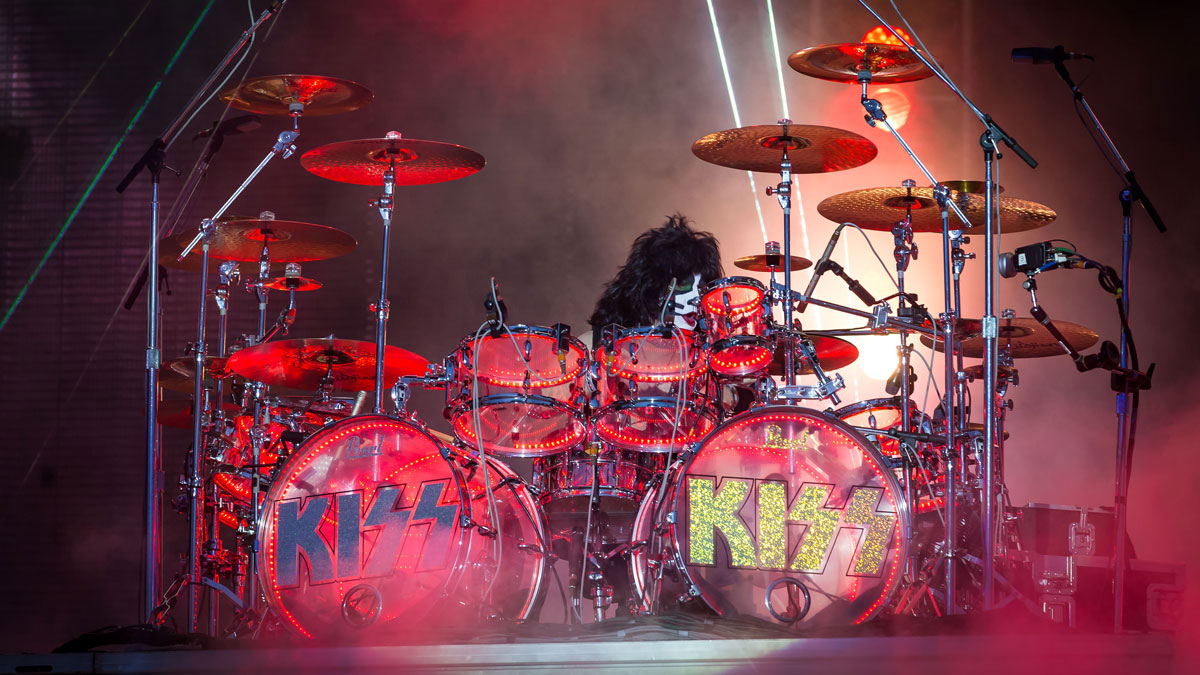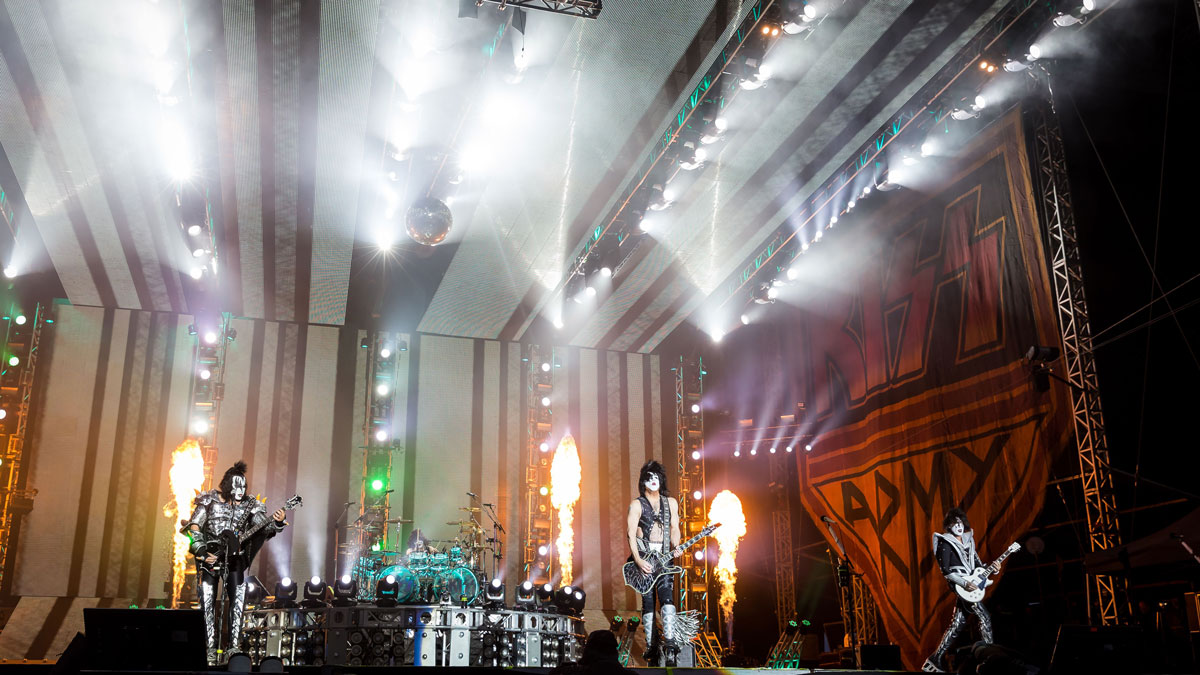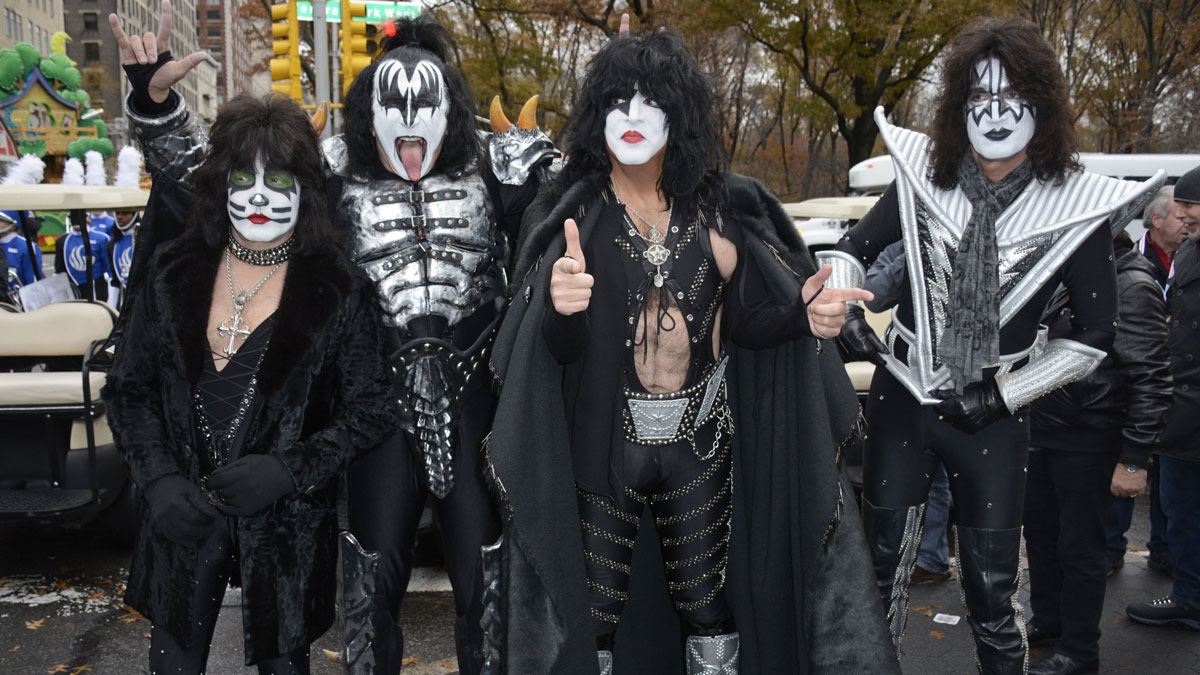Kiss's Eric Singer talks 30 years as a hard rockin' drum hero
Drum ace on his career with Kiss, Sabbath and more

30 years of rock
Eric Singer has been up late watching basketball but there’s no sign of fatigue when we sit down to talk to Kiss’s Catman about his life in music.
Over a 30-plus-year career, the fast-talking, heavy-hitting singer has played with guitar legends Gary Moore, Brian May and Lita Ford, joined Black Sabbath for three years and worked extensively with Alice Cooper. But there are few bigger gigs in rock than Kiss.
“Life works in funny ways and I don’t regret the choices I’ve made or didn’t make,” says Singer. “I have a lot of stories when I was asked to be in bands and said no and those bands were successful, but sometimes by staying the course, some connection I made manifested later down the line. Things happen for a reason.”
Singer’s drum heroes include Buddy Rich and Vinnie Colaiuta, but the Kiss gig is all about power, energy and showmanship.
“Gary Moore said to me years ago, ‘If I’m doing rock, I want a rock drummer. There is nothing I hate worse than a rock drummer trying to be a fusion drummer.’ And that stuck with me,” says Singer, who showed he can lay down the groove when backing Kiss’s Paul Stanley on his Soul Station project. “
Everybody doesn’t have to be Vinnie Colaiuta or Gregg Bissonette where you’re a chameleon. If you go, ‘I’m a rock drummer, that’s what I do,’ that’s cool too, because you can make a living and be successful. So what works for you.”
I know it’s a cliché but life is a chain-link fence, everything connects to something else.
Was your first big break when you landed the gig with Lita Ford?
“That was in ’84. I entered a Carmine Appice drum contest in LA in September ’84. I remember it was a radio station, I think it was KLOS, you sent in a tape and from that they picked 50 people – 15 girls and 35 guys.
“They had you play at a Guitar Center in the parking lot, they set up two drum kits, one double bass kit, one single bass kit. Out of that they picked the finalists. Steven Adler was in the contest. He didn’t get picked for the finals, I remember he was upset. His mother went up to Carmine Appice, ‘How come my son Steven didn’t get picked?’ I was standing right on the sidewalk next to him while his mother was asking Carmine. It had to be an awkward moment.
“The funny thing was, three years later he’s in the biggest band in the world, so you never know how things are going to turn out. After that, fast forward, I made the finals, I didn’t win, I took third place. Some girl asked Carmine for my number, so the next day I got a call, ‘Hey, I got your number from Carmine Appice and I’m doing this video for Playboy magazine, they’re doing all these videos called women of rock.’
“I did it with a girl called Brenda Lee Holliday. Being in that drum contest, that’s how I got discovered. The guy that played bass in the video, Ray Marzano, had played with Lita. His girlfriend was Lita’s best friend. Randy Castillo was her drummer. Ray goes, ‘Randy quit, Lita doesn’t even know it yet, she’s in England with Tony Iommi,’
“He said, ‘She’s going to need a drummer, I’m going to recommend you.’ So Ray and a few other people all told Lita about me, I auditioned and got the gig. She was going out with Tony Iommi so that’s how I started playing on some of his demos and ended up in Black Sabbath. I know it’s a cliché but life is a chain-link fence, everything connects to something else.”

KISS calls
What was the path that led to you joining KISS?
“I was in a band called Badlands with Ozzy’s old guitar player Jake E Lee. We started that band after the Gary Moore tour and we got a record deal around the Fall of ’88. I actually quit the band halfway through the recording process, then they convinced me to stay and we decided to regroup and write new songs. ‘Let’s go to New York and get a change of scenery.’
“While we were there, this bassist Dennis St James was managed by the same people and he was going to be playing with [guitarist] Bob Kulick on Paul’s solo tour. He asked the management, ‘Hey, what’s Eric doing? Paul Stanley needs a drummer.’
On some of the songs you can hear me clicking the sticks or counting things off, you hear some of those noises in the background. I like that...
“I met with Paul, I brought him some Black Sabbath CDs. He told me he was trying to get either me or Gregg Bissonette but Gregg wasn’t available. That night Jason Flom, who was our A&R guy, happened to be at the China Club which was a popular hangout where people jammed in New York City. He goes, ‘Hey, I just ran into Paul Stanley, he told me you’re playing drums on his solo tour.’ That’s how I found out.
“The minute I got home that next day to LA I got a call saying, ‘Paul decided he wants to start rehearsals earlier.’ I had to turn around and fly back to New York and really start cramming on learning the songs.”
How did the band work in the studio on the most recent albums Sonic Boom and Monster?
“The way we did the last two records, the band played live in the studio. We didn’t play with a click track. One song on the newest record I played with a click track only because it was a song we literally wrote on the spot.
“If you’re playing and everybody is making mistakes you’re not going to get the track. I thought, let’s play to a click, let’s at least get the drums. I did it mainly for expediting the process, but other than that every other thing was played live as a band. You get it warts and all but that’s the thing, it’s live.
“At this point I’m pretty experienced from working in recording. All the other songs we did, we would go into a rehearsal room, jam the ideas out, get a basic arrangement so that everybody was familiar with the ideas and the riffs and had a chance to live with it, so when we got to the studio we would do two, three, or four songs at a time and we had that rehearsal tape as a point of reference for the tempo and the arrangement.
“The new record, on some of the songs you can hear me clicking the sticks or counting things off, you hear some of those noises in the background. I like that, to me that gives it that raw, really live element, which is important. That’s why we did it this way because we wanted it to be less slick and less produced in the sense of it being so perfect.”

"Music breathes. Music moves."
It’s important to give the music room to breathe?
“Music breathes. Music moves. If you listen to a symphony orchestra, you have a conductor, they’re reading sheet music, but the band has to learn how to play as an ensemble together. There’s almost this unspoken free-form time in a lot of classical music, it’s not dead set where you can tap your foot to it like a rock’n’roll song.
“Humble Pie was a great example, that band really played well together and the music moved around. You’ll feel certain sections of the song slow down and then speed up and they all do it together. They’re really feeling the music as an ensemble and to me that’s more of an orchestral, symphonic vibe where the music has that real human element.
“Sometimes that happens automatically. Many times you’ll play with another guitar player or bass player and go, ‘Wow, I played really well with this guy, we hear things the same.’ It’s true. The way you interpret things and the way you feel the beat, whether it is ahead or behind or on the mark, those little subtleties are where people say, ‘we’re really clicking together.’ It just has to do with how you hear music.”
What drums did you use for recording Monster?
“I used my old Pearl GLX kit. It’s one with those old super-Gripper lugs. There is something unique about those drums, they only made them from around ’86 to 1990, they never really caught on in America.
In the studio I don’t care about having a giant kit. Honestly I’m fine with one bass drum, one rack, and one floor tom if I really had to.
“That was my first endorsement kit that I got from Pearl in 1986. I kept those drums all these years and I’ve used them on many tours with Gary Moore, Sabbath, Badlands, even Kiss, Alice Cooper.
“Last year I decided to dig them out of the warehouse. I hadn’t used them in about 10 years and I had the kit refurbished, had the shells cut down to more standard sizes, because it was an old power toms kit. I used them on tour for a while last year and it reminded me how great these drums sounded – 12", 13", with 16", 18" floor toms, and a 24".
“I set it up as a double-bass kit but I never even put a pedal on the left drum, I only set it up because that’s what I was physically used to playing and I thought it would make it more comfortable for me.
“In the studio I don’t care about having a giant kit. Honestly I’m fine with one bass drum, one rack, and one floor tom if I really had to. But with Kiss I wanted to have the option of having more tom sounds, so I used four toms. That kit sounds really great. I used a Pearl Free Floating 14"x61⁄2" clear acrylic snare.
That drum ends up being my secret weapon whenever I’m in the studio.
“I brought in a whole arsenal of snare drums, Black Beauties, old ones from the ’30s, a Tama Bell Brass, all the different Pearl signature drums, I even had one of Cozy Powell’s drums that I got years ago, one of the Yamaha ones. It’s a really weird drum because it has this unique stringer set up on it and has these thick die-cast hoops, the strainer looks like something off a marching snare, Cozy must have had these made special for him because I’ve never seen these before or since.
“I even tried that when we were first working on rough ideas, but nothing sounded like that Pearl acrylic Free Floater. It’s weird how it would sound better than all the other drums. Usually you never go wrong using a Black Beauty in the studio, that’s always a failsafe mechanism, but that Free Floater is the one.”
Is it tough to juggle drumming and singing live?
“As long as I’m feeling healthy and I have my voice then I love singing. It’s tough sometimes when it’s 115° in Phoenix and you’re playing outside with all the flames. There are some times when playing feels like work.
“Generally, it doesn’t feel like work, I’ve got one of the greatest jobs in the world, getting to play every night for all these people, playing a giant drum kit on a huge stage, putting on a big show, it doesn’t suck. I’ve got one of the greatest drumming gigs that anybody could ever want. Every day is a new adventure.”